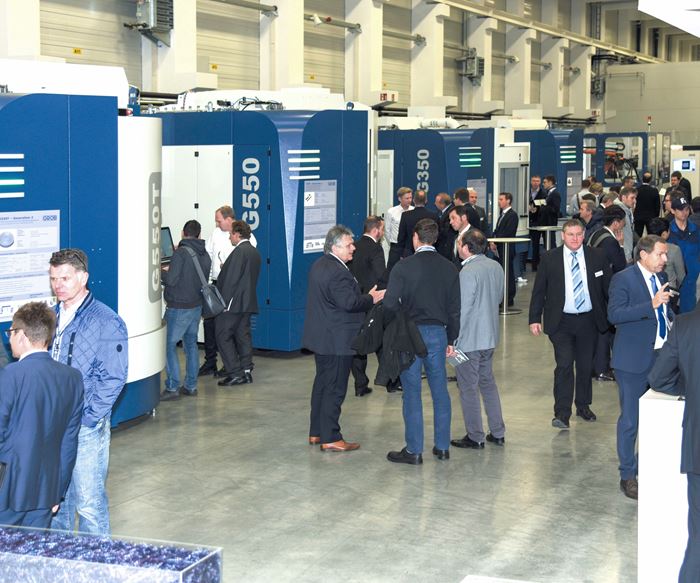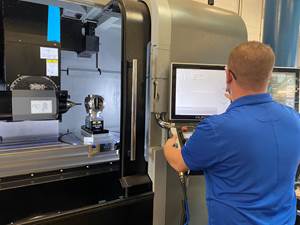Grob Goes Big on Universal Machining Centers
At an open house in Germany, Grob described its focus on the aerospace market for its line of universal machining centers.
There were smiling faces all around in Mindelheim, Germany, last November 15 when Airbus landed its biggest-ever order with a $49.5 billion deal for 430 airliners, the same day Grob’s in-house exhibition kicked off there. Known for its flexible automotive production systems, the 6,000-employee company has been constantly growing its universal machining center business. Alexander Attenberger, head of Grob’s international universal machining center sales, said during the event that his segment of the company recently has been experiencing growth in the aerospace and tool and die industries.
While 35 percent of all globally sold automotive cylinder heads are said to be made on Grob’s production systems, which consist of modular machining centers and special-purpose machines interlinked with automation solutions tailored to each customer’s needs, the company has set its eyes on the aerospace industry and its universal machining center business, which currently accounts for 10 to 15 percent of global sales. “We certainly want to grow this product line and see huge potential in the aerospace and die and mold industries, as well as the growing importance of electromobility,” Mr. Attenberger said.
He believes that the technological transition in vehicle drive systems is not regarded as a threat to the company, but as a chance to develop a new market. Consequently, Grob acquired Italy-based DMG Meccanica, a manufacturer of machines and systems to produce stators for electric motors, alternators and generators in January 2017.
While the electromobility industry is yet to take off, Grob currently sells approximately 30 percent of its universal machining centers to the aerospace industry, 30 percent to automotive, 10 percent to die and mold, and 30 percent to other industries including medical, energy and general engineering.
Grob’s Mindelheim production facility, said to be Europe’s largest machine tool campus, includes 13 production halls and 600,000 square meters of floor space, which would take a five-kilometer walk to explore. The company also has a production facility in Bluffton, Ohio. As one of four production plants worldwide, the Bluffton plant generated an output (machines produced) of approximately $243 million in 2016/17 (out of a total of approximately $1.4 billion) and employed 480 people. “The United States is a very important market for us, and similar to global developments, we hope to see major growth in our universal machining center business coming from the aerospace and tool and die industries,” Mr. Attenberger said. Next to Asia (31 percent), North and South America are among the biggest markets for the company at 30 percent of sales followed by Europe at 21 percent.
Investing in Skills
To sustain Grob’s global growth, the company has established a paid apprenticeship program, which has been globally duplicated based on the parent-company model in Mindelheim. There, 320 apprentices choose from 10 programs to become machinists, electricians, designers and mechanical engineers, among other trades. 6 percent of the company’s global staff are apprentices, and the company says that the reason is simple: Employing apprentices is a smart move because they can be trained to develop exactly the skills and knowledge the company wants them to have. In addition to their on-the-job training, they attend off-the-job training at colleges or universities if they choose to pursue an academic career after they finish their 3.5-year apprenticeship program.
“The effort pays off,” Mr. Attenberger said. “Today, whether in Germany, China or the United States, manufacturers have no option other than developing talent in house. And most of our apprentices stay to follow a career within Grob after their apprenticeship, and many of them never leave.”
Related Content
CNC Machine Shop Honored for Automation, Machine Monitoring
From cobots to machine monitoring, this Top Shop honoree shows that machining technology is about more than the machine tool.
Read MoreHow to Successfully Adopt Five-Axis Machining
While there are many changes to adopt when moving to five-axis, they all compliment the overall goal of better parts through less operations.
Read MoreDoes a Five-Axis Machine Increase Business?
Five-axis machining is enabling custom fabricator Meyer Tool to take on more complex work and helping it produce less complex jobs more efficiently.
Read MoreFearless Five-Axis Programming Fosters Shop Growth
Reinvestment in automation has spurred KCS Advanced Machining Service’s growth from prototyping to low-and mid-volume parts. The key to its success? A young staff of talented programmers.
Read MoreRead Next
The Cut Scene: The Finer Details of Large-Format Machining
Small details and features can have an outsized impact on large parts, such as Barbco’s collapsible utility drill head.
Read More3 Mistakes That Cause CNC Programs to Fail
Despite enhancements to manufacturing technology, there are still issues today that can cause programs to fail. These failures can cause lost time, scrapped parts, damaged machines and even injured operators.
Read MoreObscure CNC Features That Can Help (or Hurt) You
You cannot begin to take advantage of an available feature if you do not know it exists. Conversely, you will not know how to avoid CNC features that may be detrimental to your process.
Read More.png;maxWidth=970;quality=90)




















.png;maxWidth=300;quality=90)







